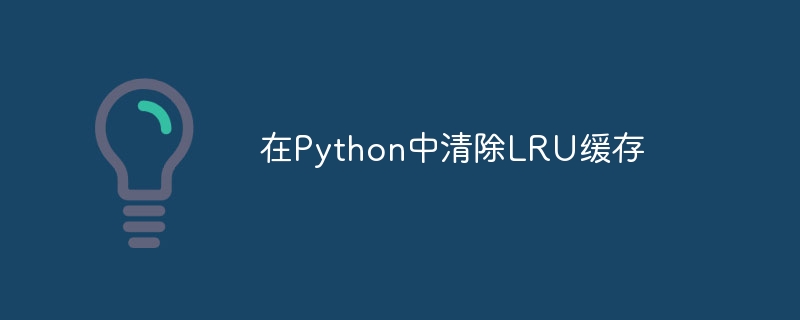
In this article, we will learn how to clear an LRU cache implemented in Python. Before we dive deep into the coding aspect, let's explore a little about what an LRU cache is and why it is popular.
LRU Cache,也被称为最近最少使用缓存,是一种在计算机科学中广泛使用的数据结构,通过减少访问频繁使用的数据所需的时间来提高应用程序的性能。LRU Cache存储了有限数量的项目,并在缓存变满时删除最近最少使用的项目。这样可以使最常用的项目保留在缓存中并快速访问,而不常用的项目则被删除以为新项目腾出空间。
LRU缓存在需要检索数据成本较高的应用程序中特别有用,例如磁盘I/O或网络访问。在这些情况下,将频繁使用的数据缓存在内存中可以通过减少检索数据所需的昂贵操作的数量,显著提高应用程序的性能。
The LRU Cache is used in a wide variety of applications, including databases, web servers, compilers, and operating systems. It is particularly useful in applications that require frequent access to a large amount of data, such as search engines and data analytics platforms.
In Python 3.2 and above, the functools module includes a powerful feature that allows programmers to interact with the LRU Cache. This feature can be utilized by using a decorator that is placed above a class or function definition. By applying this decorator to functions that require frequent variable access and changes, the performance of the function can be significantly improved.
When working with functions that require the processing of large amounts of data or complex computations, the use of an LRU Cache can greatly speed up the execution time. This is because the LRU Cache stores frequently−used data in memory, allowing the function to quickly access and process the data without incurring the cost of time−consuming I/O operations.
By utilizing the LRU Cache, Python programmers can reduce the execution time of their applications and improve their performance. This is particularly important when working with large−scale applications or those that require real−time data processing, where even small improvements in performance can result in significant gains.
总之,Python中的functools模块提供了与LRU Cache交互的强大机制。通过使用LRU Cache,程序员可以通过减少昂贵的变量访问和更改操作所需的时间来提高应用程序的性能。在需要实时数据处理或处理大量数据的应用程序中,使用LRU Cache特别有益。
Now that we know a little about LRU cache, let's make use of it in Python.
Python中functools模块的cache clear()方法可以用于清除LRU(最近最少使用)缓存。
The cache is fully cleared using this technique.
from functools import lru_cache @lru_cache(maxsize=128) def some_function(arg): # function implementation return result # clear the cache some_function.cache_clear()
In the above example, some_function is decorated with lru_cache, which creates an LRU cache with a maximum size of 128. To clear the cache, you can call the cache_clear() method on the function object, which will remove all the entries from the cache.
请注意,调用cache_clear()将清除所有参数的缓存。如果您想要清除特定参数的缓存,您可以使用不同的缓存实现,例如functools.typed_lru_cache,它允许您使用带有参数的cache_clear()方法来清除特定参数的缓存。
现在让我们利用上面的代码,写一个可工作的示例。
考虑下面显示的代码。
from functools import lru_cache
@lru_cache(maxsize=128)
def fibonacci(n):
"""Return the nth Fibonacci number."""
if n < 2:
return n
return fibonacci(n-1) + fibonacci(n-2)
# Call the function with some arguments to populate the cache
print(fibonacci(10)) # Output: 55
print(fibonacci(15)) # Output: 610
# Clear the cache
fibonacci.cache_clear()
# Call the function again to see that it's recomputed
print(fibonacci(10)) # Output: 55
In this example, the fibonacci function uses lru_cache to memoize its results. The cache has a maximum size of 128, so the function will remember the results of the most recent 128 calls.
We first call the function with some arguments to populate the cache. Then, we clear the cache using the cache_clear() method. Finally, we call the function again with the same argument to see that it's recomputed instead of using the cached result.
要运行上述代码,我们需要运行下面显示的命令。
Command
python3 main.py
一旦我们运行上述命令,我们应该期望输出类似于下面所示的输出。
55 610 55
If we want, we can also print the current state information of the cache as well in the above code, to do that we need to make use of the cache_info() method.
Consider the updated code shown below.
from functools import lru_cache
@lru_cache(maxsize=128)
def fibonacci(n):
"""Return the nth Fibonacci number."""
if n < 2:
return n
return fibonacci(n-1) + fibonacci(n-2)
# Call the function with some arguments to populate the cache
print(fibonacci(10)) # Output: 55
print(fibonacci(15)) # Output: 610
print(fibonacci.cache_info())
# Clear the cache
fibonacci.cache_clear()
# Call the function again to see that it's recomputed
print(fibonacci(10)) # Output: 55
print(fibonacci.cache_info())
上面的代码中,@lru cache装饰器接受可选参数maxsize,该参数指定了缓存的最大大小。
如果未定义maxsize,则缓存大小是无限的。
如果缓存已满,最近最少使用的项目将被移除,以为新项目腾出空间。
The function object itself houses the cache that @lru cache uses.
Accordingly, the cache is private to the function and is not shared by other versions of the function. Also, the different part here is the cache_info() method, which is used to print information about the LRU cache used by the fibonacci function. This includes the number of cache hits and misses, as well as the size of the cache.
要运行上述代码,我们需要运行下面显示的命令。
Command
python3 main.py
一旦我们运行上述命令,我们应该期望输出类似于下面所示的输出。
55 610 CacheInfo(hits=14, misses=16, maxsize=128, currsize=16) 55 CacheInfo(hits=8, misses=11, maxsize=128, currsize=11)
现在我们已经看到了如何清除缓存,让我们在另一个例子中使用它。
考虑下面显示的代码。
from functools import lru_cache
@lru_cache(maxsize=128)
def edit_distance(s1, s2):
"""
Compute the edit distance between two strings using dynamic programming.
"""
if not s1:
return len(s2)
elif not s2:
return len(s1)
elif s1[0] == s2[0]:
return edit_distance(s1[1:], s2[1:])
else:
d1 = edit_distance(s1[1:], s2) + 1 # deletion
d2 = edit_distance(s1, s2[1:]) + 1 # insertion
d3 = edit_distance(s1[1:], s2[1:]) + 1 # substitution
return min(d1, d2, d3)
# Call the function with some arguments to populate the cache
print(edit_distance("kitten", "sitting")) # Output: 3
print(edit_distance("abcde", "vwxyz")) # Output: 5
# Clear the cache
edit_distance.cache_clear()
# Call the function again to see that it's recomputed
print(edit_distance("kitten", "sitting")) # Output: 3
In this example, the edit_distance function computes the edit distance between two strings using dynamic programming. The function is recursive and has three base cases: if one of the strings is empty, the edit distance is the length of the other string; if the first characters of the two strings are the same, the edit distance is the edit distance between the rest of the strings; otherwise, the edit distance is the minimum of the edit distances for the three possible operations: deletion, insertion, and substitution.
为了提高函数的性能,我们使用lru_cache来缓存其结果。缓存的最大大小为128,因此函数将记住最近128次调用的结果。这样可以避免为相同的参数重新计算编辑距离。
We first call the function with some arguments to populate the cache. Then, we clear the cache using the cache_clear() method. Finally, we call the function again with the same argument to see that it's recomputed instead of using the cached result.
请注意,edit_distance函数只是一个示例,计算两个字符串之间的编辑距离还有更高效的方法(例如使用Wagner−Fischer算法)。这个示例的目的是演示如何使用lru_cache来记忆递归函数的结果。
总之,在某些情况下,清除Python中的LRU(最近最少使用)缓存可能是重要的,以管理内存并确保缓存保持最新。LRU缓存是Python的functools模块提供的内置缓存机制,可以根据函数的参数缓存函数的结果。@lru_cache装饰器用于为函数启用缓存,可以指定maxsize来设置缓存大小的限制。
修饰的函数对象的cache clear()方法可用于清除LRU缓存。通过清除所有缓存结果,该技术使缓存保持最新,同时释放内存。如果函数被更新或输入数据经常变化,清除缓存可能是必要的。
总的来说,LRU缓存提供了一种简单而有效的方法来提高Python函数的性能,特别是那些计算密集型的函数或者被多次使用相同参数调用的函数。在必要时清除缓存可以帮助保持通过缓存获得的性能提升,并确保缓存在减少计算时间方面保持有效。
以上是在Python中清除LRU緩存的詳細內容。更多資訊請關注PHP中文網其他相關文章!




